Receiver Function Adjoint Tomography for Three-Dimensional High-Resolution Seismic Array Imaging: Methodology and Applications in Southeastern Tibet

Abstract
A new technique for P-wave receiver function (PRF) inversion, within the framework of wave equation-based adjoint tomography and referred to as receiver function adjoint tomography (RFAT), has been developed to obtain models of Vp, Vs, and density. This innovative technique fits the synthetic PRFs with observed PRFs and can better image the lateral variations of Vs from the crust to the uppermost mantle than traditional 1-D PRF inversion. We utilized RFAT to perform high-resolution imaging beneath a dense seismic array in Southeastern Tibet, revealing low-velocity zones extending from the uppermost mantle to the crust, as well as an eastward dipping Moho under the Red River Fault (RRF). Our inversion results provide direct evidence for the existence of a distinct asthenospheric upwelling channel beneath the RRF, and further highlight the effectiveness of RFAT for accurately imaging subsurface structures.
Type
Publication
Geophysical Research Letters